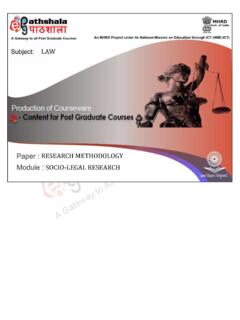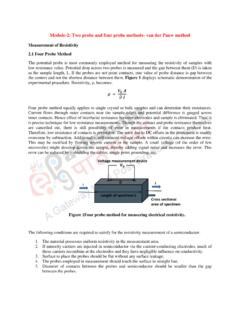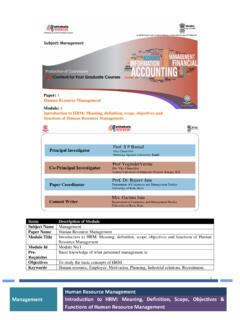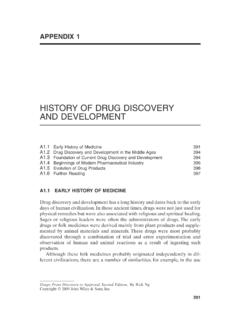Transcription of Application of Genetic Engineering
1 1 Application of Genetic Engineering 2 Application of Genetic Engineering Description of Module Subject Name Paper Name Module Name/Title Application of Genetic Engineering Dr. Vijaya Khader Dr. MC Varadaraj 3 Application of Genetic Engineering 1. Objectives Understand the concept of Genetic Engineering Discuss an outline of the different approaches and strategies of Genetic Engineering Explain the various Application of Genetic Engineering Understand the underlying ethical considerations related to Genetic Engineering 2. Concept Map Genetic Engineering : collection of techniques that alter the Genetic constitution of cells or individuals 4 Application of Genetic Engineering 3. Description Involves four basic steps of RDT / Molecular cloning 1. Isolation of DNA fragments 2. Joining the DNA fragments to a suitable vector 3.
2 Introduction of the vector into a host cell 4. Selection of colonies with desired sequence Generation of Genetically Modified Organisms (GMOs) Has Applications in Basic Research Food Industry Crop and Animal trait improvement Environmental Restoration Pharmaceutical and Health But raises some Legal and Ethical Questions 5 Application of Genetic Engineering Concept of Genetic Engineering By definition, Genetic Engineering is the direct alteration of an organism's genome which is achieved through manipulation of the DNA. This is achieved by using recombinant DNA technology which involves different techniques to insert, alter, or cut out pieces of DNA that contain one or more genes of interest. This is also known as Genetic modification, gene transfer or transgenesis. Doing this is possible because DNA is like a universal language; all DNA for all organisms is made up of the same nucleotide building blocks. Thus, it is possible for genes from one organism to be read by another organism.
3 Main focus of Genetic Engineering is: Gene isolation, Gene modification so that they can be transferred into and function within a new organism of a different species (transgenics) or the same species (cisgenics), Gene removal, and Evaluating the success of resultant gene combinations. In practice, since DNA contains the genes to build certain proteins, by changing the DNA sequence, attempts are on to design a new gene for a cell/organism resulting in a different protein and also making a cell capable of performing the desired functions. The resultant organism is broadly referred as genetically modified organism (GMO). The final aim of Genetic Engineering in higher eukaryotes results in two broad classes of GMOs which are: Genetically Modified Plants / Animals are designed for expression of the cloned genes for basic research on gene expression or for the production of useful proteins in tissue culture. Transgenic Plants / Animals are designed as a result of alteration of the Genetic makeup of the organism in which all the cells will carry the Genetic modification (shown in fig.)
4 1.) Genetically Modified Organisms Developed by Gene Transfer methods such as Transformation, Transduction to transfer genes to microbial cells ; electroporation, gene gun or biological entry mechanism such as lentiviruses and Agrobacteria to transfer genes to animal and plant cells respectively. 6 Application of Genetic Engineering Schematic illustration depicting the underlying goals in development of Genetically Modified Micro-organisms/Plants/Animals and Transgenic organisms. General strategy for gene cloning Transgenic Plants / Transgenic Animals CISGENIC Developed as a result of transfer of oligonucleotides from the same/similar species Genetically Modified Micro-organisms/Plants/Animals TRANSGENIC Developed as a result of transfer of oligonucleotides from different organisms -Alteration of the Genetic makeup of the organism resulting in Genetic modification of all the cells.
5 -For trait improvement of plants and animals for agriculture, and efficient production of valuable to derive economic benefits. - For basic research as it helps in understanding the complex processes of inheritance, expression and regulation of genes -Helps in better understanding of various Genetic disorders and effective treatment for the same - For the production of useful products after expression of cloned genes Goals achieved Goals achieved 7 Application of Genetic Engineering To achieve the aims of Genetic Engineering , a cloning strategy has to be devised that will enable efficient use of the technology. There are basically four stages to any cloning experiment (Fig. 2.).These are: 1. The isolation and preparation of DNA fragments 2. Production of recombinant by joining the fragments to a suitable vector 3. Introduction of the vector into a host cell 4. The screening of the recombinant host carrying the desired gene.
6 The successful completion of gene cloning results in a specific DNA sequence, which may be commercially applied for a variety of purposes like production of recombinant proteins, genetically modified microorganisms, transgenic plants and transgenic animals. The most suitable bacterial host is Escherichia coli for the following reason: Complete knowledge of the gene structure, Faster growth rate, Easy to culture and handle 8 Application of Genetic Engineering The different steps in a gene cloning. 1. Isolation of DNA fragments 2. Ligation of the fragments to a suitable vector to develop a recombinant DNA 3. Introduction of the recombinants in a host cell 4. Screening of the recombinants 9 Application of Genetic Engineering Besides the commendable characters of E. coli as a suitable host, the isolation and purification of the product becomes difficult owing to the presence of inclusion bodies in the host cell.
7 Also, the expression of a eukaryotic gene becomes problematic in a prokaryotic host as many key elements of eukaryotic gene expression are generally absent in prokaryotes. These are: Chromatin and small RNAs regulation pre-mRNA processing Lack of intron region Lack of RNA-splicing machinery Post translation modification system By cloning a cDNA form of the eukaryotic gene, the problem of intron can be avoided and incompatibility problems can be avoided by using eukaryotic cells as hosts. The use of eukaryotic host is the preferred choice and for this reason yeast, insect and mammalian cells are encouraged. Yeast cells are considered to be a suitable host as: Being single-celled fungi, they are easy to grow unlike most eukaryotes. The genome of yeast is designed to form Yeast artificial chromosomes (YACs) by combining the essential component of a eukaryotic chromosome like an origin site for replication, a centromere, and two telomeres which can be ligated with foreign DNA and thus serve as a vector.
8 The YAC vectors can carry larger size eukaryotic foreign DNA compared to a plasmid. They are capable of doing post-translational modifications of the expressed eukaryotic proteins. 10 Application of Genetic Engineering However, eukaryotic proteins which require specific modifications, the successful cloning requires to be carried out in animal host. Dealing with animal and plant hosts the problem lies in the introduction of the foreign DNA into the organism. Hence, different techniques are employed to facilitate entry of foreign DNA into eukaryotic cells. Some of these techniques are: Direct DNA uptake involves the uptake of foreign DNA directly from the surroundings so the uptake is less efficient. Electroporation involves creation of a temporary hole in the plasma membrane by a brief electrical pulses through which foreign DNA can enter. Microinjection involves injection of DNA into individual cells using microscopically thin needles.
9 Entry by biological means involves the use of infectious agents such as lentiviruses to transfer genes to animal cells or Agrobacteria to transfer Genetic material to plants (shown in ). Once the DNA finds its entry inside the cell, it is incorporated into the cell s genomic DNA by Genetic recombination. 11 Application of Genetic Engineering Cloning strategy in plants using Ti plasmid as a vector 12 Application of Genetic Engineering History of GMO Development Paul Berg in 1972 produced the first recombinant DNA molecules. With advancement, it is now possible to manipulate, remove, and add genes to a variety of different organisms to induce a range of different traits. Herbert Boyer and Stanley Cohen in 1973 created the first genetically modified bacteria followed by a number of remarkable achievements in this field. Some of the major achievements of Genetic Engineering are: 1974: GM mice was created 1976: Commercialization of the technology after which producing and selling genetically modified foods and medicines began.
10 1982: The first commercial development of GMOs (insulin-producing bacteria) 1994: began to sell genetically modified food 1997:The first successfully cloned large mammal (sheep) named Dolly was developed 2003: began to sell GMOs as pets ( Glofish ) A number of notable achievement since then involves development of drugs, such as treatments for cancer; development of transgenic insect-resistant crops; and development of transgenic animals for production of growth hormones and pharmaceutical products. The expression of trans-genes is possible in transgenic organisms as the Genetic sequences for proteins are similar. The transgenic organisms are now developed to produce, various substances such as foods, pharmaceuticals, biochemical etc. Now it is possible to clone plants, fish, and even livestock. 13 Application of Genetic Engineering 4. Application of Genetic Engineering The number of applications for Genetic Engineering are increasing as more and more is learned about the genomes of different organisms.















